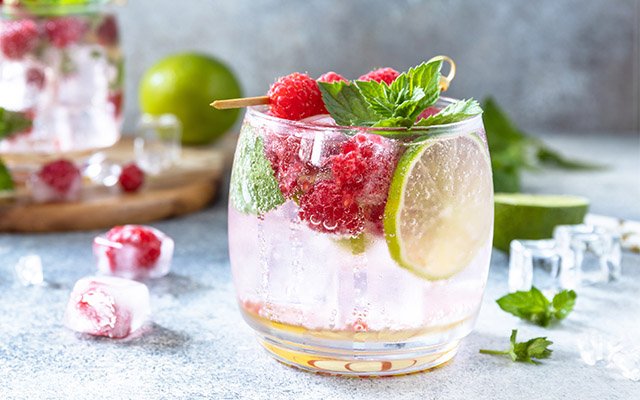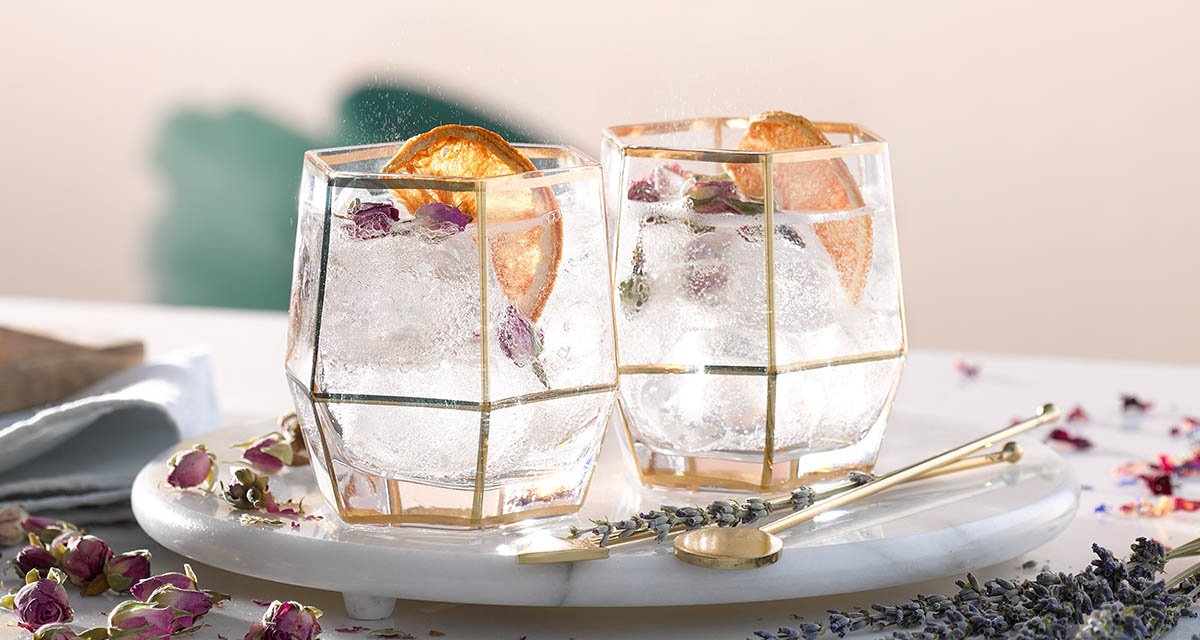If you love gin as much as we do then you have probably already mastered the perfect gin and tonic recipe, and you are probably already a scholar of London dry gin. But how familiar are you with gin’s best friend and most famed partner-in-crime, tonic water?
Sure, you’ve heard of Schweppes and Fever-Tree, and if you are a Craft Gin Club member you will no doubt have a whole range of exciting new and unique tonic waters in your gin cupboard. But what is tonic water?
Can you name the key tonic water ingredients? Do you know when tonic water was first invented and by who? Do you know what health benefits tonic water might have or which tonic goes with which gin?
In this feature, we are revealing all. Be warned, some of the answers may surprise you. Scroll down to take a look!
What is tonic water?
Tonic water is a clear, bitter, carbonated soft drink made with quinine (a natural-occurring alkaloid found in the bark of the cinchona tree).
It is most commonly used as a mixer for gin but can also be drunk on its own or mixed with other spirits.
As many gin fans will know, the most common and popular examples of tonic water are Schweppes Tonic Water and Fever-Tree Tonic Water.
Image: Schweppes
However, there are lots of different varieties and brands of tonic water out there to explore.
When was tonic water invented?
Tonic water as we know it today was patented in 1885 by Erasmus Bond. He owned a company called Pitt & Co. based in Islington, London. He marketed tonic water as a general tonic for any ailment and as a digestive.
However, people had been mixing quinine with soda water, sugar and sometimes alcohol long before this because quinine was used as a treatment for malaria in India and other British colonies.
The sugar and alcohol helped to mask the bitter quinine (a spoonful of sugar helps the medicine go down).
The anti-malarial properties of the cinchona tree, from which quinine is derived, were actually first discovered and brought to Europe from South America, in the Andies, in the 17th Century when Spanish explorers were introduced to the bark by the indigenous peoples there.
The first mention of a “gin and tonic” as a cocktail, and therefore of tonic water as a mixer, is thought to be in an 1868 issue of Oriental Sporting Magazine.
In their book, Just the Tonic: a Natural History of Tonic Water, Kim Walker and Mark Nesbitt say that Oriental Sporting Magazine described people calling for a gin and tonic with cigars after a horse race in Lucknow, India.
How is tonic water made?
At its most basic, tonic water is made by mixing quinine and carbonated water together.
Different tonic water makers will then add sugar to sweeten the mixture and fruit, herb and spice products to flavour the tonic water.
How do you store tonic water?
If unopened, tonic water should be stored at room temperature out of direct sunlight - humidity is the enemy! A pantry is usually the best place for storing unopened tonic.
Once opened, tonic water should be stored in the fridge with the lid sealed.
Can tonic water go off?
Tonic water can go off.
Signs that your tonic water has gone bad include the liquid taking on a yellowish colour and the bubbles disappearing. If your tonic has gone flat, discoloured or has a strange odour then it is probably time to get rid of it.
It is always best to check the expiration or “best by” date on the bottle or can before opening it. Once opened, tonic water should stay at its best for up to four days if stored in the fridge as described above.
What is the taste of tonic water?
Tonic water has a delectably bitter taste from its key ingredient, quinine.
You can also expect the taste profile of tonic water to include subtle citrus, herb and sweet tastes depending on the brand of tonic water you choose.
Are tonic water and soda water the same?
While they may look similar, tonic water and soda water are not the same products.
They are different both in terms of ingredients and flavour profile. Soda water is not simply tonic water without quinine.
Tonic water is made with carbonated water, quinine, sugar and other ingredients to add flavour to the liquid. Soda water is carbonated water and sodium bicarbonate with nothing else added.
Soda water has a very subtle saltiness and tastes clean and watery. Traditional tonic water has a bitterness that is often accompanied by sweet tones and other flavours depending on each brand’s own specific recipes.
Which tonic water has the most quinine?
East Imperial claims to make the tonic water with the most quinine on the market right now.
Which tonic water is best for gin?
With such a huge variety of tonic waters out there today, from Schweppes Tonic Water and Fever-Tree’s range of tonic waters to the Artisan Drinks tonic waters and Llanllyr Source Tonic Water, it really is down to personal taste when picking the best tonic water for you and your gin.
However, we have a couple of recommendations to help you get started.
Here are 4 of the best tonic water and gin pairing suggestions:
Pair London dry gin and Navy Strength gin with classic tonic water (often referred to as “Indian” tonic water) and light tonic water.
Classic tonic water is made for the quintessential gin profiles of London dry gin and Navy Strength gin.
Those traditional bitter quinine tones, often with light touches of citrus and other botanical ingredients, work SO well with the complex, rich juniper-forward palate of good craft gin.
We recommend trying Llallyr Source Tonic Water with York Gin London Dry Gin for a stunning classic gin and tonic pairing.
Pair Old Tom gin with Mediterranean tonic water.
Old Tom gin, the grandfather to London dry, is a slightly sweet gin, often with subtle spiced or barrel-aged characteristics. It is a great partner to the herbaceous tones of a good Mediterranean tonic.
Try Whitby Gin Wild Old Tom Edition with Fever-Tree Light Mediterranean Tonic Water for a G&T experience like no other.
Pair citrus-forward gins with floral or herb-forward tonic waters. Think elderflower and mint flavours!
Citrus tones never fail to complement the likes of elderflower, rose, and green herb notes.
Together, they give you a G&T that’s ideal for the summer months and just as good at any other time of the year too.
Give Tarquin’s Pink Lemon, Grapefruit And Peppercorn Gin a go with Lixer Elderflower & Lemon Tonic Water for summer in a G&T.
Pair pink or sloe gin with citrus-flavoured tonic waters.
Often sweet, juicy and fruity or berry-licious, pink and sloe gins and citrus-flavoured tonic waters are a match made in heaven.
Sloe gin and berry-forward gins are often rich and sweet and full of complex hedgerow tones, the citrusy palate of a lemon or orange-flavoured tonic is the perfect way to complement those flavours without overpowering them.
We recommend trying Elephant Sloe Gin with Artisan Drinks Yuzu Tonic Water for an unforgettable sloe gin and tonic.
Image: Fever-Tree. Both Mermaid Zest Gin and Fever-Tree tonics are available on the Craft Gin Club online shop here!
Is tonic water good for you?
Healthwise, there aren’t many nutritional or medicinal perks to drinking tonic water. But is tonic water just sugar water? Absolutely not!
This complex mixer is made with quinine, which is used as a treatment for malaria. And it often includes other ingredients to help flavour the liquid like herbs and citrus fruit. We think the variety that comes from those flavours can be good for the soul, at the very least.
What is tonic water good for?
The main thing that tonic water is good for is mixing with gin!
Many people claim to use tonic water to settle the stomach, but there is very little evidence to say this works and tonic water is not recommended as a remedy for stomach aches by the NHS.
So let’s not use tonic water for tummy aches or any other medical condition, let’s use it to elevate our gins as only it can!
Will tonic water help with leg cramps?
The NHS does not recommend using tonic water to help with leg cramps but you can find out more about what the NHS does recommend for leg cramps right here.
The idea that tonic water can help with leg cramps may have come about because doctors sometimes prescribe quinine tablets to deal with leg cramps in severe cases and as a last resort.
As quinine is an ingredient in tonic water, people may be under the misconception that it will have the same effect as the tablet.
However, quinine tablets usually contain 200mg or 300mg of quinine. Tonic water usually contains around 83mg of quinine per litre.
On this issue, Doctors Hope Ricciotti and Hye-Chun Hur commented:
“Drinking a few ounces of tonic water shouldn't be harmful, but it isn't likely to prevent your leg cramps. There are a few other things you can do, however. Because cramps are often caused by dehydration, make sure to get enough fluids.” [Harvard Health Publishing, Harvard Medical School Newsletter]
No, gin fans, a G&T does not count as “fluids” in this case, as much as we wish it did!
So there you have it, everything you could possibly wish to know about tonic water. That was thirsty work, it’s definitely time for an ice-cold G&T. Cheers!


























 plus all of your
plus all of your
 See Bronze Benefits
See Bronze Benefits
 plus all of your
plus all of your
 See silver Benefits
See silver Benefits
 plus all of your
plus all of your
 See gold Benefits
See gold Benefits